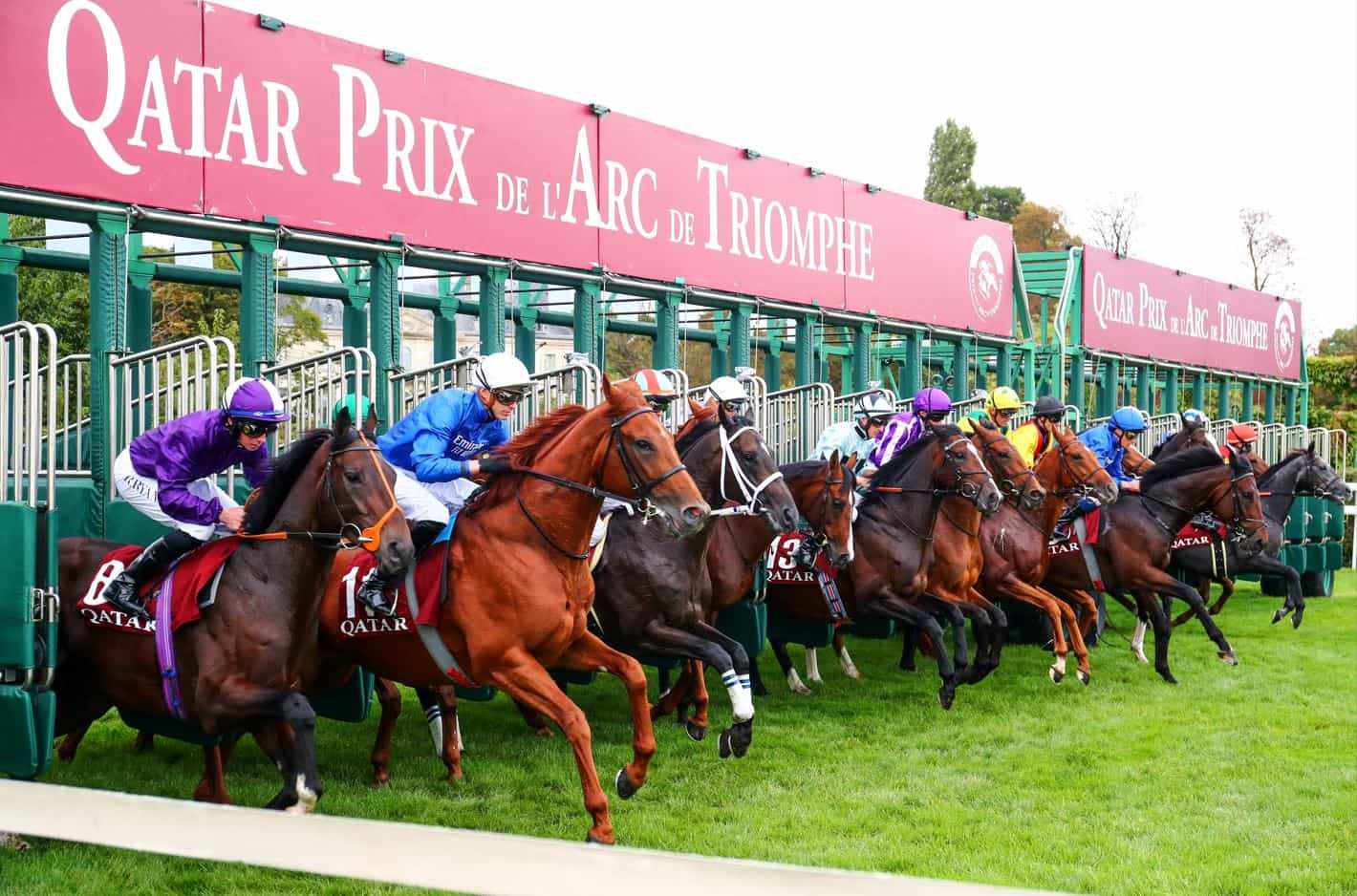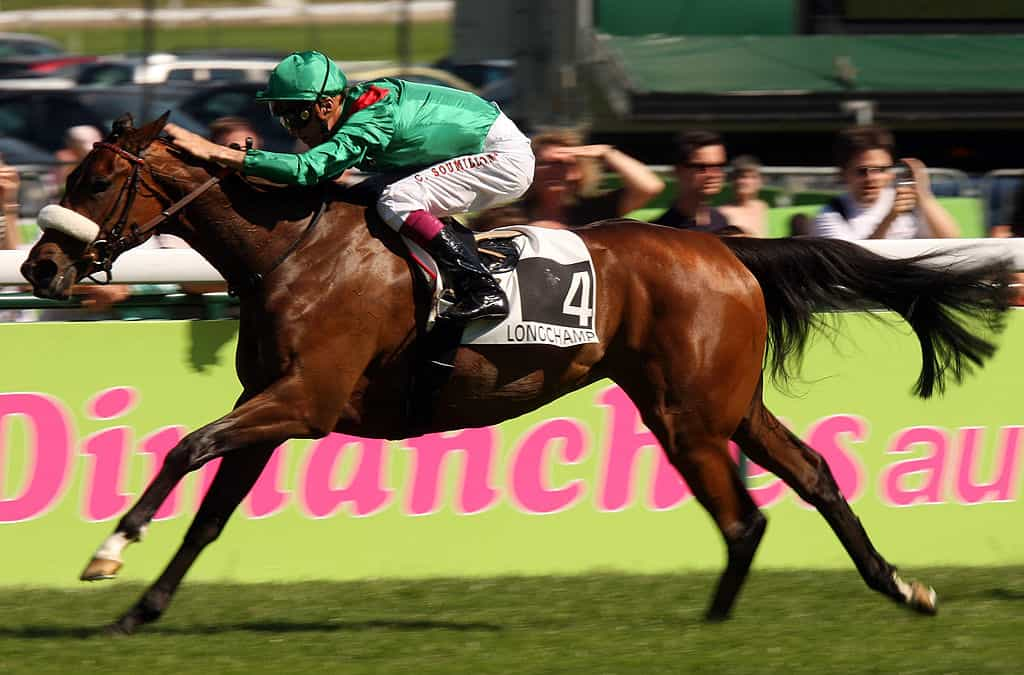Why Prestige Wins the Prix de L’Arc de Triomphe Every Time
The Prix de l’Arc de Triomphe is the world’s most prestigious all-aged horse race. It is also Europe’s richest contest, boasting a €5 million prize pool. Staged at the beautiful Longchamp Racecourse in Paris, the race represents one of the most sought-after prizes in horse racing.
A world championship in everything but name, the Prix de l’Arc de Triomphe is traditionally staged on the first Sunday of October. It attracts contenders and racegoers from around the globe and is broadcast live in 60 countries.

Based on previous results, a high draw in the Prix de l’Arc de Triomphe can be considered disadvantageous. ©GettyImages
The famous Group-1 contest was first staged in 1920, and Japanese trainers have been trying to win the race since 1969. During the past two decades, Japanese stables have brought quality and ever-increasing quantity to tackle the 2,400-metre challenge. So far, a Japanese horse is yet to claim the prize. Will horseracing’s emerging superpower strike gold sometime soon?
Please read our guide below to understand why the Prix de l’Arc de Triomphe is so special. Here you will discover the countries, horses, owners, trainers, and riders that have etched their names on the Prix de l’Arc Triomphe trophy. You can Identify the best betting value for this year’s race and even plan the easiest way to attend the Arc weekend in person.
How Did the Prix de l’Arc de Triomphe Get Its Name?
In 1863 French racing authorities created the Grand Prix de Paris, which served as a vehicle for the winner of the English Derby to compete against that of the Prix du Jockey Club, or French Derby, over 3,000 metres.
A second similar race, the Prix du Conseil Municipal, made its debut in 1893. This contest – still run today but now called the Prix du Conseil de Paris – was for three-year-olds and above. However, runners would incur weight penalties for past performances.
Plans for a third major contest to be hosted by Longchamp were drawn up in 1920. The new race was designed to complement the Grand Prix de Paris but to have similar characteristics to the Prix du Conseil Municipal. All horses would compete on equal terms in this contest, unpenalized for previous victories.
Coming in the wake of World War I, ‘Prix de la Victoire’ was considered as the name of the new contest. It was eventually decided to call the race the ‘Prix de l’Arc de Triomphe’ referencing the famous Paris monument that had been the scene of a victory parade by Allied forces following the conclusion of World War I in 1919.
The breakout of World War II led to the cancellation of the 1939 and 1940 l’Arcs. The 1943 and 1944 renditions of the race took place at the Paris Tremblay course over 2,300 metres. The only other years that Longchamp did not host the contest were in 2016 and 2017, when Chantilly acted as a caretaker while a new grandstand was built at France’s premier flat-racing course.
Who Have Been the Most Successful Arc Owners and Breeders?
Following the success of Alpinista in the 2022 Prix de l’Arc de Triomphe, Kirsten Rausing, the owner and breeder of the multiple Group-1 winner, said: “Winning the best race in the world, the Prix de l’Arc de Triomphe, represents the pinnacle of most thoroughbred breeders’ ambitions. Achieving that unrealistic objective was beyond my wildest dreams.”
French entrepreneur Marcel Boussac is the most successful owner/breeder of Arc winners. He tasted Prix de l’Arc de Triomphe success six times. His winners were Corrida (in 1936 and 1937), Djebel (1942), Ardan (1944), Caracalla (1946), Coronation (1949).

Zarkava was the last horse to carry the Aga Khan silks to l’Arc de Triomphe victory. ©GettyImages
Khalid Abdullah also owned the winners of six l’Arc de Triomphes. Amongst his winners, 2006 scorer, Rail Link, Workforce (2010), and Enable (2017 and 2018) were all bred by his Juddmonte Farms. Similarly, the Aga Khan silks were carried by six Arc winners: Migol (1948), Nuccio (1952), Akiyda (1982), Sinndar (2001), Dalakhani (2003) and Zarkava (2008).
Which Trainers and Jockeys Have the Best Arc Record?
André Fabre, who continues to train despite being in his late 70s, has won the big race eight times. His Arc De Triomphe winners are Trempolino (1987), Subotica (1992), Carnegie (1994), Peintre Celebre (1997), Sagamix (1998), Hurricane Run (2005), Rail Link (2006) and Waldgeist (2019).
Frankie Dettori holds the record for the most victories as a jockey. His six triumphs came courtesy of Lammtarra (1995), Sakhee (2001), Marienbard (2002), Golden Horn (2015), Enable (2017 and 2018). Freddy Head, Pat Eddery, Thierry Jarnet, Yves Saint-Martin and Olivier Peslier each took four Arcs. Lester Piggott retired with three Prix de l’Arc de Triomphe successes on his CV.
Recent Prix de l’Arc de Triomphe Winners
The list of recent l’Arc de Triomphe winners shows there have been two back-to-back winners since 2013. In total, eight horses have won the Arc twice. Five-year-olds have scored twice in the past four years. However, before that, there were only two five-year-old winners between 1975 and 2019.
| Year | Winner | Age | SP | Trainer | Owner |
|---|---|---|---|---|---|
| 2022 | Alpinista | 5 | 33/10 | Sir Mark Prescott | Luke Morris |
| 2021 | Torquator Tasso | 4 | 72/1 | Marcel Weiss | Rene Piechulek |
| 2020 | Sottsass | 4 | 73/10 | Jean-Claude Rouget | Cristian Demuro |
| 2019 | Waldgeist | 5 | 131/10 | Andre Fabre | Pierre-Charles Boudot |
| 2018 | Enable | 4 | Evens | John Gosden | Frankie Dettori |
| 2017 | Enable | 3 | 10/11 | John Gosden | Frankie Dettori |
| 2016 | Found | 4 | 6/1 | Aidan O’Brien | Ryan Moore |
| 2015 | Golden Horn | 3 | 9/2 | John Gosden | Frankie Dettori |
| 2014 | Treve | 4 | 11/1 | Criquette Head | Thierry Jarnet |
| 2013 | Treve | 3 | 9/2 | Criquette Head | Thierry Jarnet |
| 2012 | Solemia | 4 | 33/1 | Carlos Laffon-Parias | Olivier Peslier |
| 2011 | Danedream | 3 | 20/1 | Peter Schiergen | Andrasch Strake |
| 2010 | Workforce | 3 | 6/1 | Sir Michael | Stoute Ryan Moore |
| 2009 | Sea the Stars | 3 | 4/6 | John Oxx | Michael Kinane |
| 2008 | Zarkava | 3 | 13/8 | Alain de Royer-Dupre | Christophe Soumillon |
| 2007 | Dylan Thomas | 4 | 11/2 | Aidan O’Brien | Kieren Fallon |
The 2016 Prix de l’Arc de Triomphe was remarkable for two reasons: Trainer Aidan O’Brien was responsible for the first three home – Found, Highland Reel and Order of St George – and all three horses were sired by Galileo.
Prix de l’Arc de Triomphe Notable Stats
There have been three winning favourites since 2009, and no horse aged six or older has won the Arc since 1932. Fillies and mares have enjoyed excellent recent success in the Prix de l’Arc de Triomphe with Zarkav (2008), Danedream (2011), Solemia (2012), Treve (2013 and 2014), Found (2016), Enable (2017 and 2018) and Alpinista (2022) all scoring.
French-trained horses have kept the trophy at home 68 times. British runners have won 15 l’Arc de Triomphes. Ireland has claimed the prize eight times. Italy, with six successes and Germany, twice successful, complete the list of nations that have won the Prix de l’Arc de Triomphe.
Eighteen horses returned to defend their Arc title the following season and failed. The most recent was Torquator Tasso, who finished third in 2022. Fifteen other horses failed to win the Arc the year before they won it. Sottsass, third in 2019, was the most recent.
Solemia is the only one of the last 15 Arc winners not to have previously landed a Group-1. She had scored at Group-2 level and was Group 1 placed on the outing before her l’Arc de Triomphe success.
Who Were the Best l’Arc de Triomphe Winners?
The biggest margin of victory is six lengths. Three horses have won the Arc by that distance: Ribot (1956), Sea Bird (1965) and Sakee (2001).
Mill Reef was the Arc’s most celebrated winner of the 1970s. In his three-year-old season, the American-bred horse was runner-up in the 2000 Guineas but went unbeaten through the Derby, Eclipse Stakes and King George VI & Queen Elizabeth before landing the European showpiece.
Dancing Brave was the most memorable Arc winner of the 1980s, and he had a similar profile to Mill Reef. An unlucky runner-up in the Derby, he won the 2000 Guineas, Eclipse and King George VI & Queen Elizabeth Stakes in 1986 before his success in Paris. 13 years after his Arc victory, the Independent Newspaper described Dancing Brave as “the greatest British Flat champion of the last quarter of a century”.
The 2009 winner, Sea The Stars, is considered one of the most outstanding Arc winners of the modern era. His margin of victory was two lengths, but his Prix de l’Arc Triomphe success represented his sixth successive Group-1 victory as a three-year-old.
In 2019, Enable went close to winning an unprecedented third Arc de Triomphe. She finished second in her hat trick attempt and returned to contest the Arc for a fourth time in 2020. On both occasions, the Oaks winner with £10 million in banked prizemoney, started as the odds-on favourite.
The Arc’s Entry Criteria, Weights and More
The Prix de l’Arc de Triomphe is open to three-year-olds and above, but geldings are excluded. Three-year-olds carry eight-stone 12-pound in the Arc. Horses aged four and older carry nine-stone five-pound. Fillies and mares receive a three-pound allowance.
In 2023 the maximum field size for the Prix de l’Arc de Triomphe will rise from 20 to 24. History shows a low draw is favourable, and a high draw is disadvantageous.
The Prix de l’Arc de Triomphe is not part the World Pool. But the French tote, run by Pari Mutuel Urbain (PMU), has more than 100 partners in 57 countries. It will ensure race day betting pools will be bulging.
Prix de l’Arc de Triomphe Betting Options
Domestically, the race is broadcast on ITV Racing and Sky Sports. The best live streaming betting sites also show the Arc, and, with so much interest, online sportsbooks offer a plethora of betting markets.
Arc de Triomphe betting begins the moment the horses cross the line. The winner will be quoted for the following year’s race almost immediately and thus creating an ante-post betting market that remains open for 12 months. The Prix de l’Arc Triomphe odds will change as the season’s significant races unearth new candidates.
On race day, the top Arc de Triomphe betting sites will promote a buffet of opportunities and offers. For example, as a non-handicap, the Arc should pay each-way terms of positions 1-2-3. But punters who shop around will find online betting sites promoting 1-2-3-4 positions and even 1-2-3-4-5.
The Best Way to Attend the l’Arc de Triomphe
It is estimated that more than fifty per cent of the Arc de Triomphe’s 35,000 race day attendees visit Longchamps from overseas. Every year a significant proportion of the racegoers come from Japan. The country has yet to win the Arc, but its racing fans are passionate, and in 2022 they had four runners to support.
For the Japanese, the journey to Paris is not straightforward. However, English and Irish fans can make the journey easily in just a few hours. Amongst the best options, you can fly into Paris Charles de Gaulle Airport and then take a taxi to the course. It will cost around €80 and you will arrive in 30-35 minutes.
Alternatively, a Eurostar train from St Pancreas Station will arrive in Paris Gare du Nord two-hours-and-twenty minutes after it departs London. Our research shows booking a ticket in advance for the Saturday before the Arc can cost as little as £51. Taking an early Eurostar on race day – if booking early – will cost circa £120. From Gare du Nord, Longchamps is a 15-minute and €25 taxi drive away.
Racecourse entry tickets are relatively cheap compared to their British counterparts at major meetings. We recommend you book them online and early, as some enclosures – such as the Winning Post Gold Stand – can sell out quickly.
Francegalop-live.com is the best place to purchase your tickets. €20 will give you access to the Arc Garden, and for €65, you can view the action from the edge of the course by the winning line. ‘Bistro Triomphe’ tickets, which come with seating and lunch, are €145 (and €29 for children under 12). Organisers make concessions for two-day passes if you plan to attend the Saturday racing in addition to Arc day.



